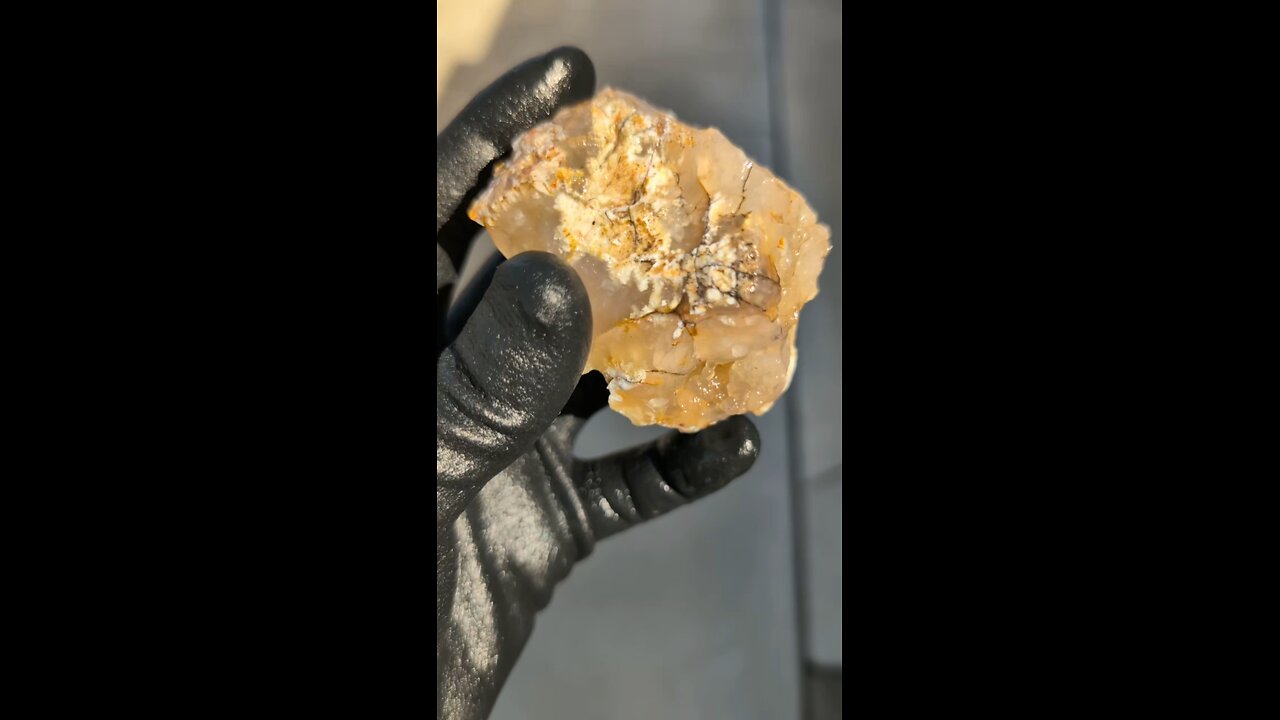Premium Only Content

Interesting Botryoidal Formation!
A botryoidal formation refers to a mineral structure that resembles a cluster of grapes or small, rounded, and knobby protrusions. Here are some details about botryoidal formations:
Characteristics:
Shape: The term "botryoidal" comes from the Greek word "botryoeides," meaning "grape-like." These formations have a surface that looks like a bunch of grapes.
Texture: They typically have a smooth, rounded surface, which can sometimes be polished to enhance their appearance.
Formation:
Process: Botryoidal formations occur when minerals precipitate from solution in a manner that favors the growth of rounded, nodular shapes. This often happens in cavities or vugs where mineral-rich fluids slowly deposit layers over time.
Common Minerals: Minerals that commonly form botryoidal structures include:
Hematite: Often found in botryoidal forms, giving a shiny, metallic luster.
Malachite: Known for its vibrant green color in botryoidal formations.
Goethite: Can exhibit botryoidal textures, often with a brownish to yellowish hue.
Chalcedony: Sometimes forms botryoidal structures, especially in agates.
Examples:
Botryoidal Hematite: Often found in iron-rich environments, it has a metallic sheen and can be polished to a high gloss.
Botryoidal Malachite: Famous for its green color and banding, often found in the oxidized zones of copper deposits.
Locations:
Botryoidal formations can be found worldwide in various geological settings where mineral precipitation occurs, from mines to natural rock formations.
Uses:
Decorative: Botryoidal minerals are popular in mineral collections and for decorative purposes due to their unique and attractive appearance.
Jewelry: Some botryoidal minerals like malachite are cut and polished for use in jewelry.
Botryoidal formations are fascinating because they provide insight into the conditions under which they formed, often indicating slow, steady mineral deposition in specific environmental conditions.
Plume agate is a distinctive variety of agate, known for its unique and intricate patterns that resemble plumes, feathers, or even landscapes. Here are some key points about plume agate:
Formation: Plume agate forms when silica-rich solutions seep into cavities in volcanic rocks. The "plumes" are created by manganese or iron oxides that get trapped in the silica, forming these feather-like patterns.
Colors: The colors of plume agate can vary widely depending on the minerals present. Common colors include reds, browns, yellows, blacks, and whites, with the plumes often contrasting against the base color of the agate.
Locations: Notable locations where plume agate is found include Oregon in the United States (specifically, the Owyhee Mountain area), Mexico, and Brazil. Each location can produce agates with unique characteristics.
Uses: Plume agate is popular among collectors and is often used in jewelry like pendants, rings, and beads due to its aesthetic appeal. It's also valued in metaphysical communities, where it's believed to enhance one's connection to the Earth, promote creativity, and aid in grounding.
Care: Like other agates, plume agate is relatively hard (about 6.5-7 on the Mohs scale), making it durable for jewelry. However, it should be protected from sharp blows or extreme temperature changes to avoid cracking.
Identification: When identifying plume agate, look for the characteristic plume-like inclusions. These inclusions should appear as if they are floating within the stone, giving a 3D effect when viewed from different angles.
Plume agate's beauty lies in its natural patterns, which can look like trees, clouds, or even abstract art, making each piece unique.
-
 1:00:50
1:00:50
VINCE
3 hours agoThe Pro-Crime Left Is Officially Finding Out | Episode 108 - 08/21/25
128K115 -
 44:15
44:15
Nikko Ortiz
1 hour agoLive - News, Politics, Podcast And Naaah Im Playin We Chillen
6.3K2 -
 1:56:55
1:56:55
Dear America
4 hours agoLUNATICS Protest DC Crime Being Down 30%?! + FBI Catches A TOP MOST WANTED!!
80.8K39 -
 2:59:39
2:59:39
Wendy Bell Radio
7 hours agoThe Easy Way Or The Hard Way
47.2K58 -
 2:14:46
2:14:46
Matt Kohrs
13 hours agoBuckle Up! Markets Get Tilted || LIVE! Day Trading Futures & Options
37.6K3 -
 LIVE
LIVE
GritsGG
3 hours agoWin Streaking! Most Wins 3390+ 🧠
45 watching -
 LIVE
LIVE
LFA TV
5 hours agoLFA TV ALL DAY STREAM - THURSDAY 8/21/25
4,889 watching -

bstrui
3 hours agoStar Wars Jedi: Fallen Order and maybe a switch up later
14.6K1 -
 4:00:19
4:00:19
The Bubba Army
1 day agoAnother LopSided Jake Paul Fight? - Bubba the Love Sponge® Show | 8/21/25
107K6 -
 1:02:42
1:02:42
Dialogue works
1 day ago $5.32 earnedJohn Helmer: Trump Ditches Ceasefire? Despite EU & Zelensky Pressure
81.6K24